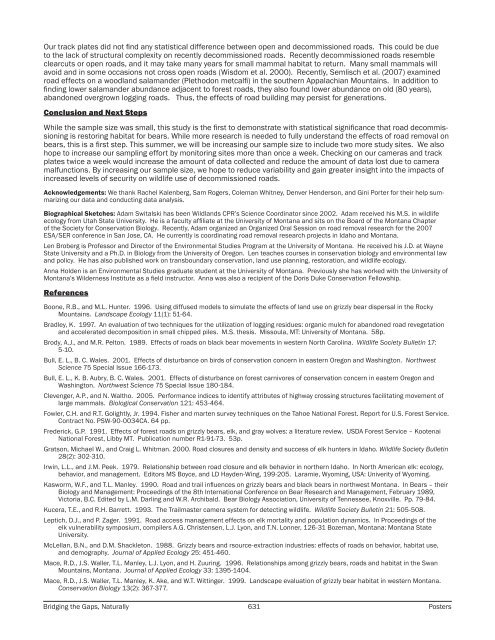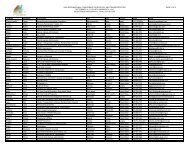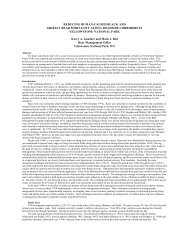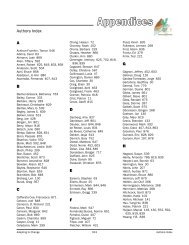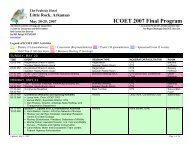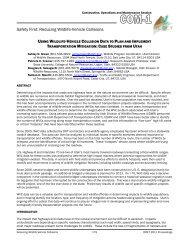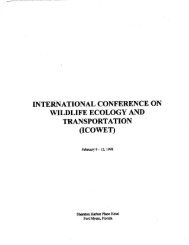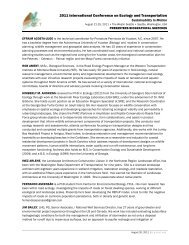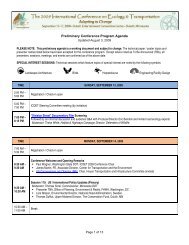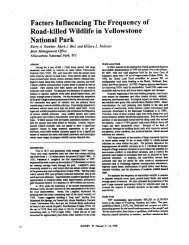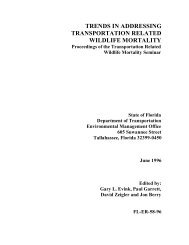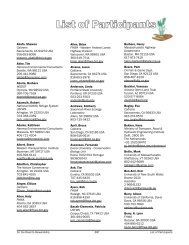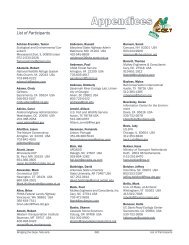Poster Sessions, pages 567-640 - ICOET
Poster Sessions, pages 567-640 - ICOET
Poster Sessions, pages 567-640 - ICOET
Create successful ePaper yourself
Turn your PDF publications into a flip-book with our unique Google optimized e-Paper software.
Our track plates did not find any statistical difference between open and decommissioned roads. This could be due<br />
to the lack of structural complexity on recently decommissioned roads. Recently decommissioned roads resemble<br />
clearcuts or open roads, and it may take many years for small mammal habitat to return. Many small mammals will<br />
avoid and in some occasions not cross open roads (Wisdom et al. 2000). Recently, Semlisch et al. (2007) examined<br />
road effects on a woodland salamander (Plethodon metcalfi) in the southern Appalachian Mountains. In addition to<br />
finding lower salamander abundance adjacent to forest roads, they also found lower abundance on old (80 years),<br />
abandoned overgrown logging roads. Thus, the effects of road building may persist for generations.<br />
Conclusion and Next Steps<br />
While the sample size was small, this study is the first to demonstrate with statistical significance that road decommissioning<br />
is restoring habitat for bears. While more research is needed to fully understand the effects of road removal on<br />
bears, this is a first step. This summer, we will be increasing our sample size to include two more study sites. We also<br />
hope to increase our sampling effort by monitoring sites more than once a week. Checking on our cameras and track<br />
plates twice a week would increase the amount of data collected and reduce the amount of data lost due to camera<br />
malfunctions. By increasing our sample size, we hope to reduce variability and gain greater insight into the impacts of<br />
increased levels of security on wildlife use of decommissioned roads.<br />
Acknowledgements: We thank Rachel Kalenberg, Sam Rogers, Coleman Whitney, Denver Henderson, and Gini Porter for their help summarizing<br />
our data and conducting data analysis.<br />
Biographical Sketches: Adam Switalski has been Wildlands CPR’s Science Coordinator since 2002. Adam received his M.S. in wildlife<br />
ecology from Utah State University. He is a faculty affiliate at the University of Montana and sits on the Board of the Montana Chapter<br />
of the Society for Conservation Biology. Recently, Adam organized an Organized Oral Session on road removal research for the 2007<br />
ESA/SER conference in San Jose, CA. He currently is coordinating road removal research projects in Idaho and Montana.<br />
Len Broberg is Professor and Director of the Environmental Studies Program at the University of Montana. He received his J.D. at Wayne<br />
State University and a Ph.D. in Biology from the University of Oregon. Len teaches courses in conservation biology and environmental law<br />
and policy. He has also published work on transboundary conservation, land use planning, restoration, and wildlife ecology.<br />
Anna Holden is an Environmental Studies graduate student at the University of Montana. Previously she has worked with the University of<br />
Montana’s Wilderness Institute as a field instructor. Anna was also a recipient of the Doris Duke Conservation Fellowship.<br />
References<br />
Boone, R.B., and M.L. Hunter. 1996. Using diffused models to simulate the effects of land use on grizzly bear dispersal in the Rocky<br />
Mountains. Landscape Ecology 11(1): 51-64.<br />
Bradley, K. 1997. An evaluation of two techniques for the utilization of logging residues: organic mulch for abandoned road revegetation<br />
and accelerated decomposition in small chipped piles. M.S. thesis. Missoula, MT: University of Montana. 58p.<br />
Brody, A.J., and M.R. Pelton. 1989. Effects of roads on black bear movements in western North Carolina. Wildlife Society Bulletin 17:<br />
5-10.<br />
Bull, E. L., B. C. Wales. 2001. Effects of disturbance on birds of conservation concern in eastern Oregon and Washington. Northwest<br />
Science 75 Special Issue 166-173.<br />
Bull, E. L., K. B. Aubry, B. C. Wales. 2001. Effects of disturbance on forest carnivores of conservation concern in eastern Oregon and<br />
Washington. Northwest Science 75 Special Issue 180-184.<br />
Clevenger, A.P., and N. Waltho. 2005. Performance indices to identify attributes of highway crossing structures facilitating movement of<br />
large mammals. Biological Conservation 121: 453-464.<br />
Fowler, C.H. and R.T. Golightly, Jr. 1994. Fisher and marten survey techniques on the Tahoe National Forest. Report for U.S. Forest Service.<br />
Contract No. PSW-90-0034CA. 64 pp.<br />
Frederick, G.P. 1991. Effects of forest roads on grizzly bears, elk, and gray wolves: a literature review. USDA Forest Service – Kootenai<br />
National Forest, Libby MT. Publication number R1-91-73. 53p.<br />
Gratson, Michael W., and Craig L. Whitman. 2000. Road closures and density and success of elk hunters in Idaho. Wildlife Society Bulletin<br />
28(2): 302-310.<br />
Irwin, L.L., and J.M. Peek. 1979. Relationship between road closure and elk behavior in northern Idaho. In North American elk: ecology,<br />
behavior, and management. Editors MS Boyce, and LD Hayden-Wing, 199-205. Laramie, Wyoming, USA: Univerity of Wyoming.<br />
Kasworm, W.F., and T.L. Manley. 1990. Road and trail influences on grizzly bears and black bears in northwest Montana. In Bears – their<br />
Biology and Management: Proceedings of the 8th International Conference on Bear Research and Management, February 1989,<br />
Victoria, B.C. Edited by L.M. Darling and W.R. Archibald. Bear Biology Association, University of Tennessee, Knoxville. Pp. 79-84.<br />
Kucera, T.E., and R.H. Barrett. 1993. The Trailmaster camera system for detecting wildlife. Wildlife Society Bulletin 21: 505-508.<br />
Leptich, D.J., and P. Zager. 1991. Road access management effects on elk mortality and population dynamics. In Proceedings of the<br />
elk vulnerability symposium, compilers A.G. Christensen, L.J. Lyon, and T.N. Lonner, 126-31 Bozeman, Montana: Montana State<br />
University.<br />
McLellan, B.N., and D.M. Shackleton. 1988. Grizzly bears and rsource-extraction industries: effects of roads on behavior, habitat use,<br />
and demography. Journal of Applied Ecology 25: 451-460.<br />
Mace, R.D., J.S. Waller, T.L. Manley, L.J. Lyon, and H. Zuuring. 1996. Relationships among grizzly bears, roads and habitat in the Swan<br />
Mountains, Montana. Journal of Applied Ecology 33: 1395-1404.<br />
Mace, R.D., J.S. Waller, T.L. Manley, K. Ake, and W.T. Wittinger. 1999. Landscape evaluation of grizzly bear habitat in western Montana.<br />
Conservation Biology 13(2): 367-377.<br />
Bridging the Gaps, Naturally 631 <strong>Poster</strong>s


